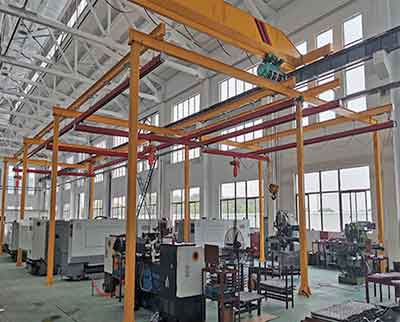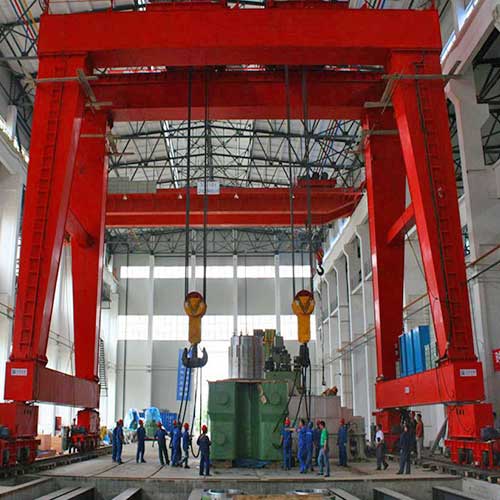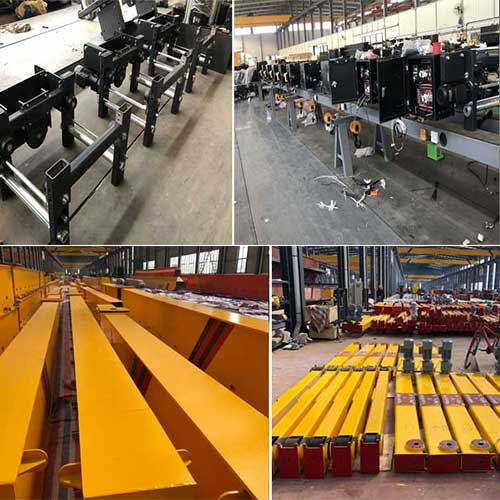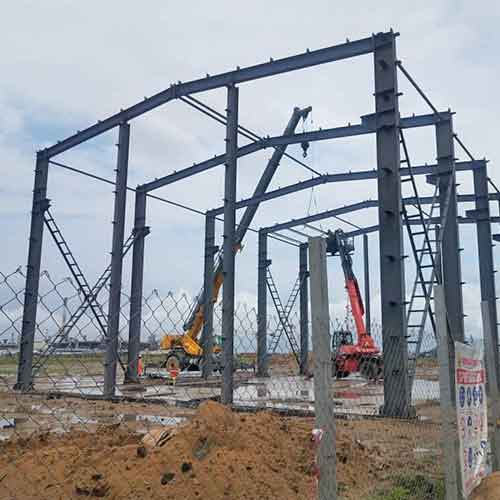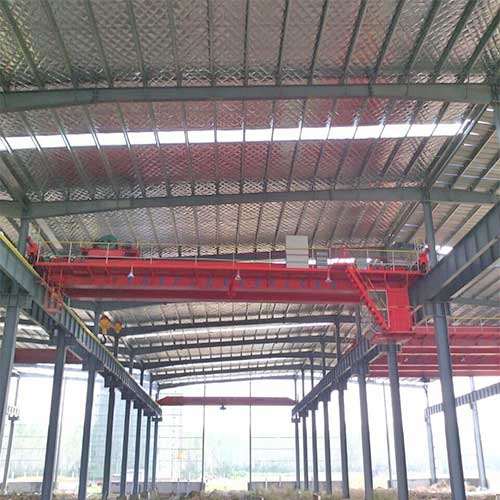Your Trusted Factory Crane Manufacturer & Supplier
Factory Crane Types:Factory Overhead Cranes & Gantry Cranes
How Does Your Factory Affect Crane Design & Installation
Factory crane for sale. Various factory crane types, ie., factory overhead crane, general use single girder & double girder overhead crane, ceiling / roof mounted & freestanding overhead crane, factory gantry crane, including portable gantry & rail travelling gantry crane, monorails, rotary crane, and wall cranes, etc. Based on your lifting requirements and application conditions. The customized factory crane can be provided.
What is a factory crane? How can a factory crane benefit your facility ?
Factory cranes are a type of safe and effective lifting equipment used to load and unload materials in a variety of industries, including the manufacturing, chemical, and mining sectors, etc.
Generally speaking, a factory crane—also known as an overhead crane—is a lifting equipment that enables material handling in your workshops both horizontally and vertically on the height of a factory. With the help of the overhead material handling equipment, lifting and moving factory equipment and products can be performed easily and quickly.
Benefits of factory crane for your material handling.
The advantages of factory cranes for businesses are enormous.
- Save your labor costs because this factory crane can do the work of many workers simultaneously, effectively replacing labor workers.
- Increase labor productivity by using a lifting process that takes less time and can lift a lot of goods and loads at once.
- The material handing overhead cranes can be used whenever necessary to help businesses and always ensure that work progresses.
- Fast and secure installation while in use. Workers only handle the remote control whereas the load handling operation process is performed by the overhead cranes.
- Low investment costs, simple installation, and renovation.
Your Trusted Factory Crane Manufacturer & Supplier
Types of Factory Overhead Cranes & Facotry Gantry cranes
Overhead Cranes & Gantry Cranes for Steel & Concreted Factory
Overhead cranes are an essential component of many modern industrial factory buildings and manufacturing plants because they are a simple and cost-effective way of moving bulky, awkward, or heavy items from one location to another. These cost-effective solutions transport heavy cargo from one area of a building to another to improve your production line efficiency and safety. Fctory cranes are classified into the following common types based on their crane structures:
Factory Overhead Cranes
- Top-running bridge cranes can handle a wide range of loads and are ideal for steel buildings with limited headroom. Single girder cranes have a lifting capacity of 1 to 20 tons and while those with double girders can lift as much as 100 tons. With top running crane design, the factory overhead cranes has no weight limited which are widely used for heavy loads handing, with large span, and lifting height.
- As for underslung bridge crane, it is used for light loads handling with capacity from 500kg to 10 ton. They are typically mounted on the roof or ceiling structure of factory facility, with short span, and light loads handling.
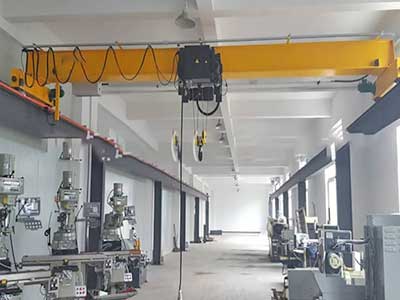
Factory overhead crane with single girder design
A single girder overhead crane that is compact and easy to install meets the basic needs of businesses.
It is a type of economical factory crane that has a reliable single-girder structure and with suspended hoist assembly to lift and lower objects and loads.
A single girder overhead crane can lift and lower medium loads weighing 500kg to 20 tons.
The outstanding benefit of the factory overhead crane is that it is small and simple to install in factories and workshops with small and medium areas
This lifting equipment also has a reliable and practical design to accommodate businesses' fundamental requirements.
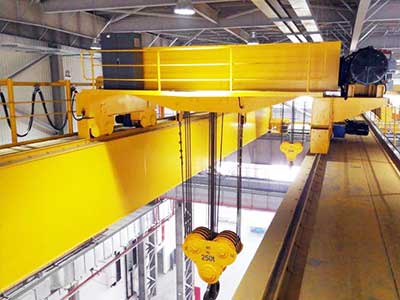
Factory overhead crane with double girder design
When factories need to lift weights of 10 tons or more, double girder overhead cranes are frequently used.
A double-girder overhead crane has two main girders, two end carriages, a working platform, a moving crab trolley, electrical wiring, and a control system, etc.
This double girder factor overhead crane has a compact design and a sturdy, stable operation. The crane's speed can be easily changed to accommodate lifting tasks.
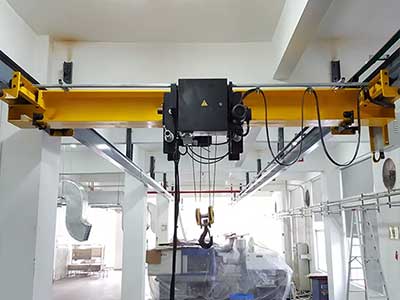
Underhung bridge cranes are a light single girder overhead crane with the travelling trolley hoists suspended and travelling along the lower flange of crane bridge. The underhung bridge crane is with lifting capacities from 1 to 10 tons and can be operated by Hand-powered or Electric power. The electric travelling underhung overhead crane are typically controlled by a pendant on the floor. These under running factory overhead cranes don't need to extend completely between building columns because they use support brackets that attach to building rafters, making them ideal for large, open spaces as well as partial aisles. Underhung cranes are generally less expensive than top-running cranes and can be coordinated with monorail trolley if desired
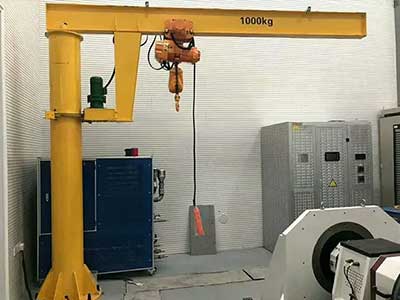
The rotary crane, with its diverse and flexible operation features, assists in moving objects to a variety of desired positions.
The rotary jib crane is made up of a column body, a main girder, a rotating mechanism, and a hoisting device that runs beneath the main girder. The horizontal jib beam will rotate around the fixed column's body for material handling.
A rotary jib crane is a type of factory overhead crane that can move and rotate objects in a specific space and perform a variety of operations. Furthermore, the rotary jib crane's design and installation are simple and quick.
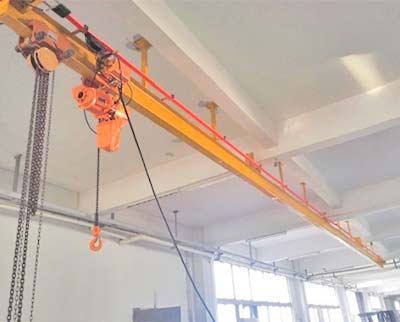
Monorail cranes provides light, efficient and economical liner material handling in factories. Depending on the demand, the beam system can be designed to travel along straight or curved single rail. This beam system serves as both a support beam and a guide beam. Monorail overhead cranes are ideal for lifting small and medium-weight objects in factories with concrete ceilings.
The Monorail crane, in particular, can run on an infinite number of rails, allowing for a broad and flexible working range based on job requirements.
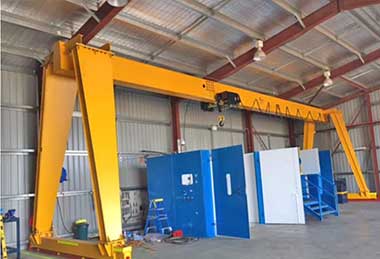
Freestanding factory gantry cranes
The A-shaped crane is widely used in manufacturing and is simple to operate.
This is one of the most common type of material handing crane used in manufacturing factory. The A shaped crane, as the name implies, has the shape of the letter A. They are very diverse in size, and can load up from 1 ton to 320 tons. As a result, A-shaped cranes are commonly used for transporting, loading, and unloading goods. Furthermore, the factory gantry crane is simple to operate with hand control, remote control or cabin control.
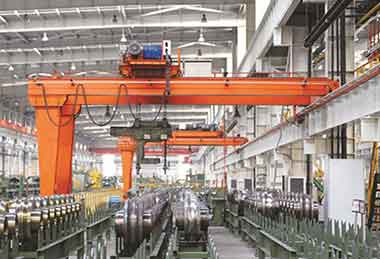
Wall cranes are popular for use in small-area factories due to their compact design.
A specially designed factory gantry crane has one single leg supported the main girder on one end and with the other end mounted on the crane's rail system, installed on the factory wall and is used to lift and lower small objects, loads and equipment.
The wall crane has the distinct advantage of being compact and taking up no space in the workshop. As a result, wall travelling gantry crane is very popular for use in factories with limited space.
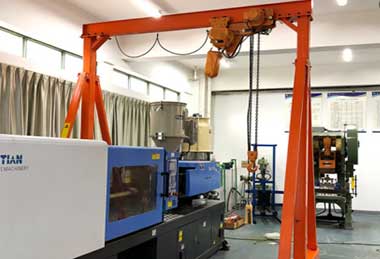
The portable gantry crane is widely used for small factory and workshop for light loads handling with capacity from 0.25 ton to 10 ton.
With roller travelling, the small factory gantry cranes provide high flexibility for loads handling around your factory.
With electric motorized travelling , the portable gantry cranes can be moved around your facility under loading. Customized portable gantry crane can be designed with capacity up to 20 ton but with higher cost.
What should you consider when selecting an factory crane?
How do I select a crane for my factory, or which cranes are suitable for a factory? The right factory crane design can lower labor costs while also improving labor productivity. And the following suggestions will help factories in increasing their use value.
Making the right crane choice is crucial. The best type of factory crane for your needs must be purchased at a reasonable cost. Even used cranes can be an expensive investment for your company, so make sure you get one that is specifically designed for the work.
1. What type of factory crane is suitable for my factory?
How to select the proper factory crane type for your factory? Generally, your can make selection factory crane types based on the following:
- By crane design and structure: single-girder, double-girder, rotary, wall-based, and monorail cranes, etc.
- By function or application conditions : machine room crane, metallurgical crane, hydroelectric crane,maintenance crane, clean room crane, explosion proof crane, etc.
Customers frequently ask us which crane is best suited for use in a factory, workshop, or indoors.
An overhead crane is the best choice because it offers the most coverage. This is because they can move and lower heavy loads back down in all three axes (X, Y, and Z) across the entire workspace.
How to select a factory overhead crane ?
You might want to buy an overhead crane for your factory to improve your producitiy and material handing safety. Bridge cranes of various types can be easily installed in your factory:
- Single-girder bridge cranes are ideal for small machine shops and warehouses.
- Double girder overhead cranes are used for large capacity heavy duty applications.
- If your factory or plant lacks a column and you need to reach a higher lifting height, a factory ceiling crane may be a better choice.
- If your industry requires higher-performance bridge cranes, consider customizing European double girder bridge cranes.
- For your particular factory conditions, we also provide specially designed explosion-proof cranes, grab overhead cranes, electromagnetic bridge cranes, metallurgical overhead cranes, and so on.
2.What is the loads the factory crane will handle?
There are numerous factors to consider, including
- whether the load is liquid, filled barrels, solid items, or a moveable load?
- Are they special loads that needs special below-hook-devices or special safety features?
- What are the sizes or volume of loads? Long pipe, sheet or unique shape?
- And load wight that you needs to handle at a time?
Crane load, and crane lifting capacity
- Crane load is the most crucial consideration when buying an factory crane. Choosing the correct load level for an overhead crane will help maximize the equipment's performance and durability.
- What is the heaviest working load your factory crane will have to lift? When it comes to lifting large loads, safety is always the primary consideration. However, if you only need to lift 3 tons, there is no sense in spending a lot of money on a crane that can lift 10 tonnes.
The load unit is kilograms or tons. According to the specification "Design load - 5 tons," this crane has a maximum lifting capacity of 5 tons. This number should be determined based on the weight of the lifting object, the frequency of work, the job characteristics, or the intended use.
Load handling properly is essential for crane safety.
- Procedures for safe load handling are covered by the OSHA standard, including adhering to rated load limits, attaching loads, moving loads, and testing load limit switches. These requirements cover both the safety of the equipment and the duties of crane operators in safe crane operation. Please contact us for more information on crane load handling safety and regulations.
3. What is your crane lifting height & factory height ?

Crane hook stroke is another name for crane lifting height. This measurement is taken from the workshop floor to the highest point of the hook. The unit is meter (m). It is essential to be aware of all the details, including workshop height, shoulder height, and overhead space restrictions, in order to provide the proper lifting height.
What is the factory height ?
The potential lift's height is just as important as its maximum weight. A good place to start is the height of your factory roof.
The clearance height is measured by first locating the lowest part of the roof and where it meets the column. A laser will provide you with an accurate measurement of the clear height from the floor to the lowest part of the roof.
This information will enable the third-party company to determine the height of the crane runway in order to avoid overhead obstructions such as lights, ceiling fans, heaters, and any utility pipes that may interfere with the crane system.
4. What is your factory crane span & factory width?
Span of factory overhead cranes

Factory crane span
The distance between the centers of two moving rails is measured as a crane span. The unit is meter (m). This parameter will be determined by the factory's actual size rather than a standard. Calculate the crane's aperture to be reasonable based on the width of the workshop to be designed. The lower the cost, the shorter the aperture, and vice versa.
Width of factory
The best factory overhead crane manufacturers will begin the quoting process by measuring the total width of the area where the crane(s) will be installed. The width measurement will include the building columns so that when approval drawings are made, you will have accurate information and will be able to maximize your space.
The overall width of this crane area, or the distance between the innermost portions of the building frames, will be examined by the project manager.
The third-party company will inspect the columns while taking measurements for your new overhead crane to look for problems, such as obstructions, piping, conduit, and any other attachments that could affect the placement of elements like the crane runway, among other things.
The person taking the measurements is essentially looking for anything that could have an impact on where the runway system's support columns are placed or the maximum height that can be used to clear overhead obstructions.
How building columns affect your factory width?What needs to know on your factory building columns?
The flange width of the column will be measured . In order to determine where the tiebacks for the floor-supported columns will be welded, they will also measure the flange thickness.Tiebacks will frequently need to be welded to the building column. A thickness check can help prevent unpleasant surprises during the installation process.

Tapered columns
When determining crane span for tapered columns, it is important to take into account the fact that the crane bay will become narrower as the columns rise.
Measurements for tapered columns differ from those for typical straight building columns. To determine the varying width differences between the top and bottom of tapered columns, it is better to measure to the outside of the columns.

Straight columns
It is much easier to measure the width of the bay if it is confirmed that the columns are the same width at the top and bottom. You'll need to know what the furthest point in on any width column is because it reduces the clear area you'll have to work with.
Obstructions and obstacles in your factory needs to be considered
- Main obstructions - any obstructions along the bay, around the general area of the crane, including from the floor to the roof, and looking through the crane area from one end to see everything as a whole, etc.
- Other obstacles to watch out for: low-hanging lights, overhead duct work, heater units, conduit running up the face of the column flanges, piping conduit, overhead ceiling fans, water supply lines, etc.
If there are any obstructions, they may need to be moved in order to attach and weld tieback braces to the faces of the building columns. The key to noting the presence of any of these impediments is to avoid surprises during or after installation.
For example, if your top unobstructed clearance is 20'2", the top of your factory overhead crane can only go up to 19'10".
The bridge crane must have a minimum of 3" of clearance over any moving objects, according to OSHA (Occupational Safety and Health Administration).
5. What is your factory crane track length & factory bay length ?

Crane runway length
The crane travelling length or running length is measured in meters (m). This length is determined by the factory's existing beam support system or by additional installation. The running length will be determined by the length of the workshop and the working range requirements of the factory crane.
It should be noted that the parameter "working range of the crane" refers to the range that the crane can approach in order to lift and lower the goods. And because the crane's operating range is always less than its running length, it is critical to determine clearly when purchasing a crane product that meets the maximum work requirements.
Measure the workshop bay's overall length to figure out how long the factory crane runway can be.
They will measure the center-to-center distances between each of the factory building columns in addition to the overall length. Usually, all of the distances will be the same in the same working bay, but any differences must be noted.
It is critical for tapered columns to be noted if they have a different length or width at the top. If you're not dealing with different-sized columns with varying widths, this will help you determine how long your span will be.
6. Lifting and lowering speed, crane movement
The crane's speed of lifting and lowering is typically designed in accordance with the manufacturer's specifications. There are typically the following categories: 1-speed, 2-speed, or variable speed are available. The cost of the finished factory crane will affectedd by the crane's speed. The most affordable crane is 1 speed factory crane.
7. How to ensure your factory crane safety ?
Safety devices & Safety tips for your factory cranes
Safety devices
In comparison to traditional cranes, industrial use factory cranes not only needs to pass our factory acceptance test, but also enable our customers to run it in a safer manner with the following crane safety system configurations.
- Lifting limiter - The hosting organization must have a hoist limiter. The hoisting tackle can actively cut off the motor's power supply when it is 300 mm from the lifting organization rack, which causes the motor to stop working. It is the safety equipment used to stop two cranes from attacking on the same trajectory or for the crane to attack before reaching the end of its trajectory.
- Active Interlocking Equipment - The majority of the active interlocking equipment is located above the overhead bridge crane. Active interlocking equipment must be installed at the warehouse doorway leading to the driver's cab to prevent electric shock to maintenance personnel. The shock absorber is a safety device that absorbs energy when the crane collides with an object and acts when the crane brake and end switch fail. When the crane is connected to the track's end column, the crane will park more smoothly.
- Brakes - Brakes are devices that allow the lifting device to suspend operation at any time during lifting, translation, and rotation, as well as to keep heavy objects at any height. It can help to avoid accidents and meet job requirements. Because the effect of the brakes is so important for the crane, a malfunction of the brakes or claps is frequently the cause of the onset of many events.
Safety tips on crane factory
The following points should be noted during the operation of enterprises in factories with cranes:
- Train workers and technicians on how to use cranes safely and efficiently.
- To prevent damage and extend the lifespan of the equipment, perform routine cleaning and maintenance on the crane.
- When installing the factory crane, it should be installed at the top so that it does not obstruct the light, affecting the activities below and the lighting system.
8. What is the factory crane price and what will affect crane cost?
What is the cost of a factory crane that will fully meet your needs after assessing all requirements? We strive to match overhead cranes to all budgets, regardless of size. For your convenience, the following factors which influence factory crane price are presented for your reference.
Total number of cranes
How many overhead cranes will be designed, constructed, and installed? Different types of factory cranes, lifting tools and approaches that can cut down on the number of cranes and equipment you might need to install, lowering your costs.
Crane capacity
The capacity of a crane, hoist, or below-the-hook lifting device refers to the maximum load that can be applied to it. In this way, every crane is special. The crane manufacturer is best suited to determine a crane's capacity because it is a variable that takes numerous factors into account. According to what they comprehend, they can assess capacity.
- The weight of the material that factory crane is going to lift
- The lifting devices or below-the-hook devices which will be attached and selected based on the loads to handle.
- Any other considerations for future need or lifting capabilities.
Numver of lifts per hour
Will your crane be operating at only 50% of its rated capacity, performing 2–5 lifts per hour? Or will it operate at or close to capacity, producing 4 lifts per hour each time? Your crane's duty cycle is an important factor in determining whether your lifting solution will meet your needs. The type of equipment you need will depend on the answer to this question, which is defined in crane classifications. While a lift system that doesn't meet your needs will wear out more quickly or may need to be replaced, over-engineering a lift will tie up capital.
Lifting height
The term "lift height" refers to how high your material needs to be raised into the air. Surprisingly, a number of factors must be taken into consideration when calculating your lift requirements, including:
- The shelves or racks that the material must be placed on,
- The elevation or height of any pits, boxes, or vehicles from which material will be lifted,
- Overhead obstructions,
- How the substance will be handled and WHY it will be moved,
- Elevation of an existing runway,
Power
Will the factory crane be powered by electricity, by hand, or by air (pneumatic)?
Operating speed
The faster the crane must operate, the faster its components wear out, so we must plan your crane use with this in mind. A process factory crane that performs 10-20 lifts per hour will require a faster bridge, trolley, and hoist than a large lift crane that requires precision but operates at slower speeds.
Working environment
The cost of an overhead crane will be affected by a tough, obstructed, or dangerous operating environment.
Environmental factors such as high heat, the presence of chemicals or fumes, steam, dust, or excess moisture can require the use of special metal coatings to protect and extend the crane's operating life. It may also require the use of specialized equipment or personal protective equipment (PPE) for installers during installation.
Obstructions can increase the cost of an factory overhead crane if installers do not have clear access to the area to remove or install an existing structure.
Runway locations
The existing environment has a large influence on the cost of a factory crane because it dictates what can be installed.
Some runway location issues that influence the cost of a factory overhead crane system are as follows:
- Is there already a runway in place? Is it strong enough to support the new crane structure?
- If a new runway system is required, will it be mounted to new support columns or tied back to the building?
- Is the flooring strong enough to support the crane's weight?
Support columns require a specific thickness of concrete to be placed on, cannot be placed over drains, or on cracked or broken concrete. We also need to take into account any wall or overhead obstructions that might require additional engineering and design considerations.
Span
Large-span cranes will require different engineering standards. Typically, the factory crane price will rise as the span widens.
And finally, never choose an overhead crane provider solely based on price! A factory crane system is a sophisticated and crucial piece of machinery used to increase the productivity, security, and efficiency of your company. It's worth the time and money to work with a crane company that understands your requirements and can provide an overhead crane system that will benefit your business in the long run.
9. How is the factory crane installation in your facility?
The overhead crane installation process begins with the purchase of the overhead crane and ends with installation, guaranteeing project completion on time and within budget. Overhead crane installation will be on the agenda once you've decided which type of factory crane is best for your application, chosen a crane builder as your supplier, and signed the crane purchase agreement.
The general procedure of overhead crane installation are simply presented for your reference:
- Evaluation of the factory crane's work scope.
- Evaluation of crane installation site.
- Evaluation of potential hazards associated with crane installation.
- Evaluate the overhead crane runway system, both the existing and new runway systems.
- Crane installation must adhere to your timetable.
- Overhead travelling crane loading test.
The general summary of factory overhead crane installation is provided for your convenience to assist you in installing your overhead cranes within your total crane budget. Please contact us or your crane manufacturer and supplier if you have any overhead crane installation needs.
Get your custom factory crane based on your factory dimensions
We design and manufacture custom factory crane solutions ranging from light-duty, low-cost cranes to large-capacity, high-duty-cycle cranes with welded plate-box girders.Main types of factory crane systems are provided, including, but not limited to: Bridge cranes,Gantry cranes,Jib cranes,Monorail cranes ,Workstation cranes, etc.
Contact us to get your customized factory crane now.
Your Trusted Factory Crane Manufacturer & Supplier
